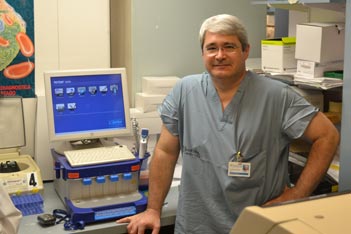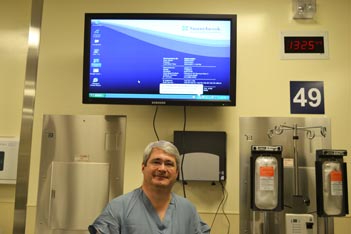Improving care of bleeding patients through research at Sunnybrook
Bleeding is a common surgical problem and a challenge
that every surgeon has to face. Bleeding is particular
challenge in trauma where it remains the most common
cause of preventable death. Bleeding can be classified
as mechanical (e.g. a lacerated liver) or coagulopathic
– when hemostasis is defective and the patient becomes
incapable of clotting effectively. Recent evidence suggests
that shock is the main cause of early coagulopathy following
trauma and not loss and consumption of clotting
elements as previously believed. The best management
of mechanical bleeding continues to be surgery while
coagulopathy is essentially treated by replacing clotting
elements with transfusion of blood product such as fresh
plasma to replace clotting factors, platelets, and cryoprecipitate
to replace fibrinogen.

Sandro Rizoli in the ROTEM Lab
The challenge in trauma is to recognize when the patient
is coagulopathic. The clinical recognition of coagulopathy
tends to be late, usually when there is diffuse nonstop
oozing from surgical incisions, tube sites, mucosa, etc.
Frequently the clinical diagnosis of coagulopathy occurs
a few minutes before cardiac arrest. It is impossible to
diagnose excessive clot breakdown (hyperfibrinolysis)
clinically, which may be more common than recognized.
A recent study published in Lancet (1) suggests that antifibrinolytic
drugs reduce mortality in trauma.
Coagulopathy is better diagnosed by coagulation lab
tests such as INR, aPTT, platelet count and fibrinogen
levels. Unfortunately these tests may not be helpful in
the context of exsanguinating hemorrhage because they
take too long to be available (often more than 1 hour);
may be normal even when the patient is markedly
coagulopathic and have no correlation with bleeding.
Remember that INR was created to evaluate coumadin
therapy, not exsanguinating surgical bleeding. The combination
of high mortality and lab tests of limited usefulness
have led many Trauma Centers in North America
to adopt Damage Control Resuscitation (DCR) for the
management of massively bleeding patients. In DCR,
all bleeding patients are presumed coagulopathic and
receive large transfusions of red cells, fresh plasma and
platelets from the start of resuscitation, while completely
ignoring the lab. The evidence supporting DCR is weak
and while it may have saved many lives, the chaotic
and unguided transfusion of massive amounts of blood
products may also have contributed to the poor outcome
of others.
Thromboelastometry (TEM) is a coagulation assay
used by some centers around the world for liver transplantation
and cardiac surgery. TEM was recently
proposed as a potentially ideal test for the diagnosis
and management of coagulopathy in massive bleeding
patients, particularly in trauma. The equipment
consists of a pin (channel) that is immersed into a
cup, containing a few drops of the patient’s blood. As
the liquid blood within the cup turns into a clot and
subsequently undergoes lysis, the viscoelastic resistance
over the pin changes and these changes are measured by
a computer that generates a graphic representation. The
graph generated and its measurements are very simple
to interpret. TEM evaluates the whole coagulation process,
from initiation to propagation to lysis. It measures
how quickly the clot is formed (that is clotting factor
dependent); the maximum strength of the clot (that
depends on platelets and fibrinogen) and also measures
clot breakdown or fibrinolysis. Another reason TEM is
considered superior to standard coagulation lab tests is
the fact it can guide transfusion (for example: patients
with excessive fibrinolysis need antifibrinolytic drugs
and not plasma transfusion). There are two different
TEM devices commercially available, but the European
model (ROTEM or rotational thromboelastometry)
is more sophisticated and performs 4 different tests
including specific ones for platelets and fibrinogen.
A few places in the world are starting to explore the
usefulness of ROTEM in trauma. In North America
Sunnybrook is the first one.
|

The Sunnybrook Trauma Program led by Homer Tien
is the largest in Canada and approximately 4% of our
patients are admitted with massive bleeding. Some of
these patients require so much blood during resuscitation
that they put at risk the blood inventory for the
city of Toronto. Massive bleeding is not only an area of
major clinical interest at Sunnybrook but also its main
focus of research. The motivation to acquire a ROTEM
was the unique opportunity it offered to advance both
trauma research and clinical care to a cutting-edge position.
First we applied for a Special Authorization from
Health Canada to use ROTEM clinically. Then the
equipment was loaned by the manufacturer and installed
with funds from the De Souza Research Chair. It has
been proposed that the equipment be installed in the
Trauma Resuscitation Room and used for point of care
testing. Thanks to Elena Brnjac and the Sunnybrook
Department of Clinical Pathology, we were able to place
the equipment in the Hospital Lab where it will be done
by trained technologists and according to the highest lab
standards. In order to have the results immediately available
for clinical decision-making, a large screen has been
placed in the Trauma Room that is directly linked to the
ROTEM in the lab. The screen will display the results
in real time and can be used to diagnose coagulopathy
and help in deciding which blood product to transfuse
and how much. Another innovation is linking ROTEM
to the Operating Rooms with similar real time display
of the results. In the OR, the test will help surgeons and
anesthetists resuscitate patients undergoing emergent
surgery. We expect to be doing ROTEM tests in all trauma
patients admitted to Sunnybrook starting July 28th.
The ROTEM project is a fascinating advance for trauma
research at Sunnybrook. Over the last years, trauma
surgeons Sandro Rizoli, Homer Tien, Lorraine Tremblay
and transfusion specialists Jeannie Callum, Bartolomeu
Nascimento, Marciano Reis have worked together in a
growing number of clinical trials focused on traumatic
coagulopathy and blood transfusion in trauma. Like
before, the current ROTEM project will have a direct
impact on patient care. The group is also conducting
the first randomized controlled trial on DCR with
funding from the Canadian Forces Health Services,
and recently created the Sunnybrook Code Omega,
a protocol for the management of massive bleeding.
Their collaboration also led to the Massive Transfusion
Consensus Conference, an international meeting held
at the Sheraton Hotel in Toronto June 9-11, 2011.
This Conference attracted world renowned surgeons,
anesthetists, hematologists and transfusion specialists. It
resulted in consensus guidelines on massive transfusion,
which will be published in Critical Care before the end
of 2011.
Even today, the mortality of the coagulopathic bleeding
trauma patients remains unacceptably high around 40%.
Our expectation in being among the first to explore
the role of ROTEM in trauma, is to be able to advance
the research on the physiopathology of coagulopathy
in trauma, improve our clinical ability to diagnose and
treat coagulopathy, make better and more rational use of
blood transfusions and reduce the enormous mortality
and suffering of these patients.
Sandro Rizoli
De Souza Trauma Research Chair
CIHR/NovoNordisk New Investigator Chief Region XII
Committee on Trauma, American College of Surgeons
References:
1. CRASH-2 collaborators, Roberts I, Shakur H, Afolabi
A, Brohi K, Coats T, Dewan Y, Gando S, Guyatt G,
Hunt BJ, Morales C, Perel P, Prieto-Merino D, Woolley
T. - The importance of early treatment with tranexamic acid
in bleeding trauma patients: an exploratory analysis of the
CRASH-2 randomised controlled trial. Lancet. 2011 Mar 26;
377(9771):1096-101, 1101.e1-2
|